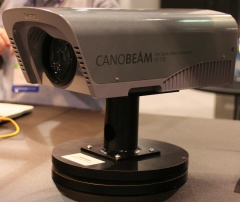Canon's FSO laser beam uplink


For the low-end CANOBEAM model DT-110 (156 mbps), you end up paying about 6 times more money with 6 times more performance compared to a low-end Cisco 1300 802.11g bridge. A pair of DT-110s is $13K list while a pair of Cisco 1300s is $2000 list price. Moving up to a pair of DT-130s gets you 1250 mbps for $28K which is a lot more bandwidth for the dollar. The DT-110 has a maximum range of 500 meters while the DT-130 has a maximum range of 1000 meters. The mid-range DT-120 for $25K has the same 156 mbps throughput of the DT-110 but it has a 2000 meter range.
All of these FSO solutions sound like a lot of money when fiber optical cable can transmit data at much higher speeds at a lower price. The problem is that it's not always cheap to run fiber and sometimes it's just impossible. Sometimes a temporary high-speed link might be needed and that's where FSO solutions shine because they can be deployed quickly and redeployed any time. For low-throughput connections, cheaper 802.11 bridges fill the gap.